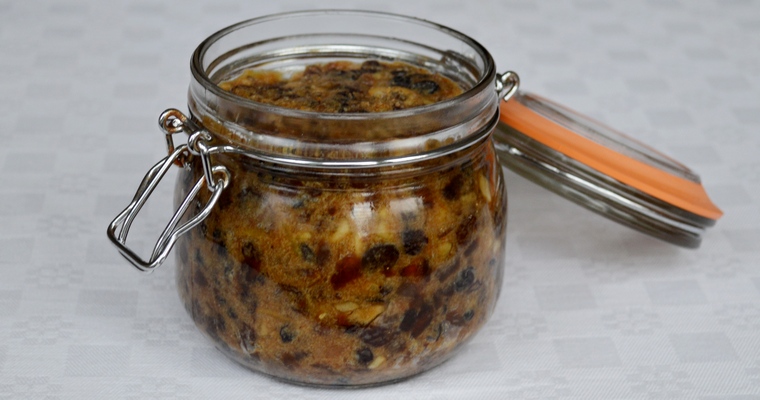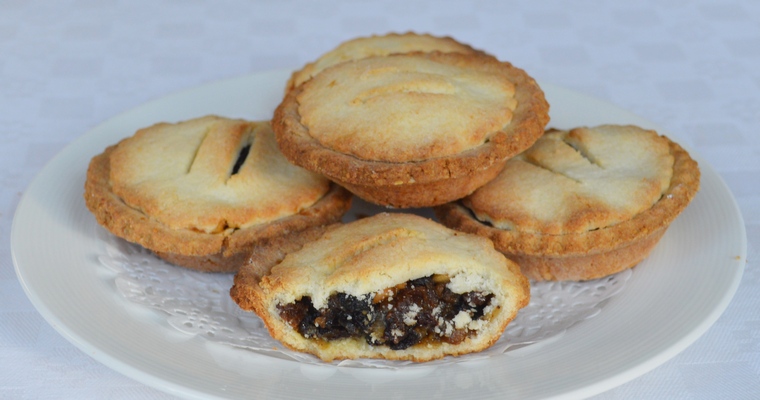Christmas in a bowl. Succulent vine fruits are mixed with Brandy, apple, zest and spices. This traditionally Dairy-free recipe uses suet rather than butter.
| Skip straight to the recipe |
01. What is mincemeat?
Mincemeat is a strongly-flavoured and succulent fruit mix that is used to fill sweet pastry cases like mincemeat tarts and mince pies. It is made by soaking a luxury assortment of dried fruit, citrus peel and apple in brandy and aromatic spices. A generous amount of shredded beef suet is also added to the mix. This melts when heated to create a uniform texture and a richer mouth-feel, and helps to meld all the fat-soluble flavour compounds together.
02. What is suet?
Suet is the hard fat that surrounds the kidneys in cattle. Suet is used instead of regular muscle fat because it is flavourless. You should be able to get suet from a good butcher. In its raw form, suet contains membranes and other matter that needs to be removed before it can be used. Your butcher should render the suet for you, so that you are left with a block of pure fat. This should be treated like meat and stored in the fridge. The suet then needs to be shredded into small shavings before it can be used – you can do this using a grater. This is because suet has a high melting point, and chopped cubes will not fully melt and incorporate into the mixture during cooking. You can buy pre-shredded suet from a butcher, or packaged suet from a supermarket, which has been dehydrated so that it can be stored in the cupboard. However, in processed suet, the shreds of fat are coated in flour to stop them from clumping together. This a problem for people who are gluten-intolerant and, more generally, the additional flour will affect the results of the recipe.
03. Why is suet used instead of butter in mincemeat?
Suet gives mincemeat a silky texture and rounds off the flavours. However, butter is the preferred solid fat for baking, as it adds a lovely rich flavour. Suet is 100% fat, whereas butter is only 80% fat – it is an actually an emulsion of butterfat and water, stabilised by milk proteins. This means that mincemeat made with suet keeps for longer, as water encourages the microbial action that causes food to spoil.
04. How much sugar should I put in mincemeat?
Mincemeat was originally a savoury concoction, containing ground meat flavoured with dried fruits and spices, and preserved in vinegar and alcohol (hence the name). As fashions and palates changed, the meat and vinegar was removed and replaced with sugar. A really successful and tasty mincemeat should contain echoes of this sweet-savoury fusion. It should have a complex flavour, and should not be overpowered by too much sugar. Shop-bought jars of mincemeat are often too sweet, being gluey and insipid.
05. Do I need to use alcohol in mincemeat?
Alcohol not only enhances the flavours, but also helps to preserve the mincemeat. This is an example of pickling, where food is preserved in a liquid that inhibits bacterial growth. Salty brine, acidic vinegar and alcohol can all be added to food to stop it from spoiling during storage. This differs from fermentation, where the food is encouraged to produce lactic acid organically, creating an inhospitable environment without the need for additional ingredients. Raw alcohol needs time to mellow. If you are making the mincemeat for immediate use, then you can use less alcohol in the mix – a couple of tablespoons will ass sufficient flavour. If you intend to keep the mincemeat for several months before using, then you should add a couple of extra tablespoons of alcohol. If you don’t want to use alcohol, then replace with apple juice or extra orange juice, and store in the fridge.
06. How do I store mincemeat?
Mincemeat is actually a bottled preserve, like jams and chutneys. Traditionally, it would be made a year ahead and aged, in order to allow the flavours time to develop and meld. The melted suet, sugar, acidic fruit juices and alcohol all act as natural preservatives. If not enough alcohol is added, the apple can ferment, which will result in a sticky liquid bubbling up and out of the jar.
07. What dishes can I use mincemeat in?
The classic use for mincemeat is to bake in a shortcrust pastry case – either in the form of Christmas mince pies, or tarts and turnovers. You can also stuff mincemeat into cored apples and bake in the oven, mix into the batter when making brownies, cakes and muffins, spoon between the fruit filling and topping in crumbles, or mix with pureed dates and ground nuts to make fruit bars. For a savoury use, you can add mincemeat to stuffing, and then spread over pork before rolling and tying, or insert under the skin of poultry.
Recipes that use mincemeat:
Tips & Tricks
- Heat the mixture before bottling – this helps to prevent the apple from fermenting by deactivating the enzymes, and by melting the suet to coat the fruit pieces.
- Adjust the amount of brandy used – alcohol preserves the mincemeat, but takes time to mellow. Use less if you are making the mincemeat for immediate use, and more if you are intending to store it for several months before using.
- Cool the mixture before adding the brandy – you don’t want to cook off all the alcohol by heating it.
- Stir the brandy in thoroughly – this stops the suet from clumping together into a white mass around the sides of the jar as it cools and solidifies.
Ingredients
- 125g sultanas
- 125g currants
- 125g raisins
- 75g dried apricots, finely chopped
- 1 small cooking apple (160g), peeled, cored and finely chopped (I used a Bramley)
- 100g honey
- 100g beef suet, grated (vegetarian, gluten-free suet is fine too)
- grated zest of 1 organic lemon
- grated zest of 1 organic orange
- 4 tablespoons (60ml) orange juice (about 1 small orange)
- 1 teaspoon mixed spice
- 1/4 teaspoon nutmeg
- 1/4 teaspoon cloves
- 4 tablespoons (60ml) brandy (or sherry)
Instructions
- Measure out all the ingredients except for the brandy into a large saucepan. Give everything a good stir. Heat gently over a low heat, stirring occasionally, until the suet has completely melted – about 10 minutes. The fruit should be glistening and surrounded by a pool of fat.
- Take off the heat, and allow the mixture to cool for 10 minutes. Add the brandy and give everything a good stir. If you are making the mincemeat for immediate use, reduce the amount of brandy to 2 tablespoons. If you are intending to store the mincemeat for longer than 3 months, add 2 extra tablespoons of brandy.
- Meanwhile, sterilise your glass jars by putting through the dishwasher on a rinse cycle without detergent, or by boiling in a large pan of water for 10 minutes, and then removing and leaving to air dry.
- Transfer the mincemeat to the sterilised glass jars, using the back of a spoon to press the mixture down and eliminate air bubbles. Seal, and store in a cool, dark cupboard. For best results, allow to mature for at least 1 month, and eat within 1 year.



